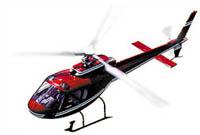NTSB Says Both Chose To Fly Into Dangerous Weather
It's likely that medical helicopter transport will always remain
a dark corner in accident statistics. A no-go call on these
missions risks a patient death, and the calling of a helicopter
usually means time is of the essence. But in two recent probable
cause reports, the NTSB notes fatal accidents resulted when pilots
took unnecessary weather risks during routine flights home, after
their patients had reached the hospital.

In the case of a September 25, 2009 accident in South Carolina,
the board determined that a pilot, identified in local media as
45-year-old pilot Patrick Walters, had transported a patient to
Charleston Hospital and was returning to his home base in Conway.
The patient flight was made in visual conditions, but an advancing
storm caused deteriorating weather.
The NTSB report reads, in part, "The Savannah base manager [for
Omniflight, the operator] advised the accident pilot that he could
stay at the Charleston base that night. However, the accident pilot
decided to return to his base at Conway-Horry County Airport (HYW),
Conway, South Carolina.
"The pilot had previously flown helicopters in IMC but was not
current in instrument ratings at the time of the accident. The
accident helicopter was not certificated for flight in IMC but had
sufficient instrumentation to operate in the event of an
inadvertent encounter with IMC. On the pilot’s last Part 135
airman competency/proficiency check, which occurred on December 12,
2008, he satisfactorily demonstrated inadvertent IMC loss of
control recovery."
Walters and two medical personnel died in the crash of the
AS-350 (file photo of similar aircraft shown) the board found no
evidence of pre-crash mechanical failure.
NTSB noted the helicopter was not equipped with an autopilot.
Probable cause was determined to be "The pilot’s decision to
continue the visual flight rules flight into an area of instrument
meteorological conditions, which resulted in the pilot’s
spatial disorientation and a loss of control of the helicopter.
Contributing to the accident was the inadequate oversight of the
flight by Omniflight’s Operational Control Center." The final
reported was dated January 19, 2012.
The other case, a March 25, 2010 crash in Tennessee, also
involved an AS-350. The Associated Press reports the NTSB said the
pilot, 58-year-old Doug Phillips, was finishing a 12-hour night
shift and told another pilot he thought he had about 18 minutes to
beat a storm moving into the area and return to his home base in
Brownsville, TN. He reportedly said he planned to make the flight
without two nurses who had been on board for the patient transport,
but they returned and boarded before he could depart.
In the narrative portion of its final report, also issued last
week, the board write, "The pilot made a risky decision to attempt
to outrun the storm in night conditions, which would enable him to
return the helicopter to its home base and end his shift there,
rather than choosing a safer alternative of parking the helicopter
in a secure area and exploring alternate transportation
arrangements or waiting for the storm to pass and returning to base
after sunrise when conditions improved.
"At the time of the accident, the pilot was nearing the end of
his 12-hour duty shift, during which he had flown previous missions
and may have had limited opportunities to rest. Further...the
accident occurred at an early hour that can be associated with
degraded alertness...
The board listed probable cause as, "The pilot’s decision
to attempt the flight into approaching adverse weather, resulting
in an encounter with a thunderstorm with localized instrument
meteorological conditions, heavy rain, and severe turbulence that
led to a loss of control."
 ANN's Daily Aero-Term (04.25.24): Airport Rotating Beacon
ANN's Daily Aero-Term (04.25.24): Airport Rotating Beacon ANN's Daily Aero-Linx (04.25.24)
ANN's Daily Aero-Linx (04.25.24) Klyde Morris (04.22.24)
Klyde Morris (04.22.24) Airborne 04.24.24: INTEGRAL E, Elixir USA, M700 RVSM
Airborne 04.24.24: INTEGRAL E, Elixir USA, M700 RVSM Airborne 04.22.24: Rotor X Worsens, Airport Fees 4 FNB?, USMC Drone Pilot
Airborne 04.22.24: Rotor X Worsens, Airport Fees 4 FNB?, USMC Drone Pilot



